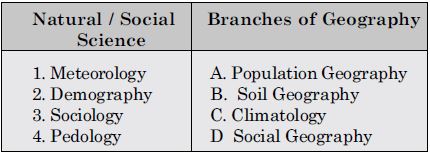Question 1:
Which one of the following scholars coined the term ‘Geography’?
- Herodotus
- Erathosthenese
- Galileo
- Aristotle
Answer:
(b). Erathosthenese
Question 2:
Which one of the following features can be termed as ‘physical feature’?
- Port
- Road
- Plain
- Water park
Answer:
(c). Plain
Question 3:
Mark correct pairs from the following two columns and mark the correct option:
- 1B, 2C, 3A, 4D
- 1D, 2B, 3C, 4A
- 1A, 2D, 3B, 4C
- 1C, 2A, 3D, 4B
Answer:
(d). 1C, 2A, 3D, 4B
Question 4:
Mark correct pairs from the following two columns and mark the correct option:
- Why
- Where
- What
- When
Answer:
(a). Why
Question 5:
Which one of the following disciplines attempts temporal synthesis?
- Sociology
- Geography
- Anthropology
- History
Answer:
(d). History
Question 6:
What important cultural features do you observe while going to school? Are they similar or dissimilar? Should they be included in the study of geography or not? If yes, why?
Answer:
Cultural features are man-made features. While going to school we observe features like roads, buildings, cars, buses, hospital and schools. All the cultural features are dissimilar due to the technology used in making them. These should be included in the study of Geography because these are included in the environment.
Question 7:
You have seen a tennis ball, a cricket ball, an orange and a pumpkin. Which one amongst these resembles the shape of the earth ? Why have you chosen this particular item to describe the shape of the earth ?
Answer:
An orange resembles the shape of the Earth. I have chosen this item as the surface of an orange is irregular, which is similar to the surface of the Earth. The Earth is also round, so an orange best resembles the shape of the Earth.
Question 8:
Do you celebrate Van Mahotsava in your school? Why do we plant so many trees? How do the trees maintain ecological balance?
Answer:
Yes, we celebrate Van Mahotsava in our school. We plant so many trees as these increase the forest area of our country. These are necessary to maintain the ecological balance and for the conservation of the environment.
Question 9:
You have seen elephants, deer, earthworms, trees and grasses. Where do they live or grow? What is the name given to this sphere? Can you describe some of the important features of this sphere?
Answer:
Living beings like elephants, deer, earthworms, trees and grasses live and grow in the environment. This sphere is called the Biosphere. The main feature of this sphere is that this is the interacting sphere of the Earth.
Question 10:
How much time do you take to reach your school from your house? Had the school been located across the road from your house, how much time would you have taken to reach school? What is the effect of the distance between your residence and the school on the time taken in commuting? Can you convert time into space and vice versa?
Answer:
The time taken to reach the school from my house is 30 minutes.If the school was located across the road from my house, it would have taken 5 mins to reach the school. When the distance between the school and home is more, the time taken is more and vice versa. Using scientific formulas, time can be used to calculate the distance between two places.
Question 11:
You observe every day in your surroundings that there is variation in natural as well as cultural phenomena. All the trees are not of the same variety. All the birds and animals you see, are different. All these different elements are found on the earth. Can you now argue that geography is the study of “areal differentiation”?
Answer:
Geography studies the earth as home of man. Geography studies the earth after getting details from both the social and natural sciences. Geography is concerned with core or place of an area. It analyses the spatial characteristics. It studies the distribution, location, centralisation and their patterns in an area. Geography is thus the study of difference of places.
Many differences are found in physical as well as cultural environment on the earth. Therefore, it is justified to state the Geography as a study of areal differentiation. Geography studies all those aspects which differ from place to place. Geography studies the cause and effect of these differences. It studies the causes of these differences. According to Richard Hartshorne, “Geography aims at the description and analysis of the areal differentiation on the surface of the earth.”
According to Alfred Hettner, “Geography studies the areal differences in different aspects on the earth on the basis of cause and effect.”
In Geography, the areal differentiation has developed alongwith the concept of region. Hettner in 1905, defined Geography as the study of places.
In 1950, Richard Hartshorne also supported the concept of areal differentiation. According to Hartshorne, ‘‘Geography is the studies of areal differentiation on the surface of the earth. It includes the climate, relief, soils, population, land use and industries. In fact, the areal differences are the basis of the study of the subject of Geography.
Question 12:
You have already studied geography, history, civics and economics as parts of social studies. Attempt an integration of these disciplines highlighting their interface.
Answer:
The subjects of Geography, History, Civics and Economics are interrelated. The geography of a place effects its history and economic structure. The political situation (civics) is a result of the geographic and historical conditions. Hence, the disciplines of social studies are integrated.

